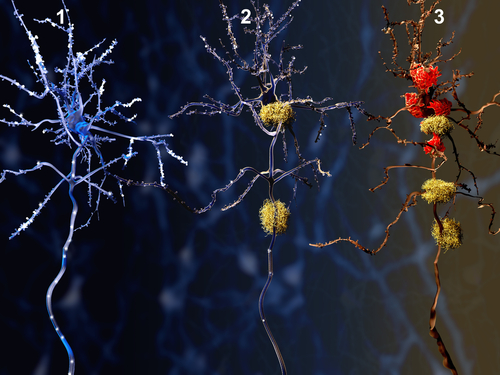HYPE Protein Shows Promise in Treating Parkinson’s Disease, Research Shows

The formation of alpha-synuclein aggregates in brain nerve cells (neurons) is thought to be one of the hallmarks of Parkinson disease. Researchers now have found that the activity of a single protein, called HYPE, may help halt alpha-synuclein accumulation and reduce its toxic outcomes, including neuronal death.
These findings, “Alpha-Synuclein Is a Target of Fic-Mediated Adenylylation/AMPylation: Possible Implications for Parkinson’s Disease,” were published recently in the Journal of Molecular Biology.
How Parkinson’s disease develops is still not well understood. However, evidence suggests that abnormal protein aggregates of alpha-synuclein, the main component of Parkinson’s disease hallmark Lewy bodies, are toxic and lead to neuronal death.
Clusters of misfolded (meaning altered structure) alpha-synuclein proteins also have been associated with disease severity. These aggregates lead to the formation of holes in the membranes of neurons, which affects their function and ability to communicate with other cells.
Previously, researchers had found that the HYPE protein can help cells cope with stress from misfolded proteins by promoting the addition of a chemical modification — called adenosine monophosphate (AMP), in a process known as AMPylation. They now asked whether HYPE also could play a role in Parkinson’s, specifically by modifying alpha-synuclein.
“Since HYPE plays such an important role in how cells deal with stress from misfolded proteins, we wondered whether diseases that result from protein misfolding were likely to need HYPE,” Seema Mattoo, PhD, an assistant professor of biological sciences at Purdue University and the study’s lead author, said in a press release.
“We know that in Parkinson’s disease, often the misfolded protein is [alpha-synuclein]. So we asked if HYPE could modify [alpha-synuclein], and if so, what are the consequences?,” Mattoo said.
Indeed, they found that HYPE is present in dopamine-producing neurons of the substantia nigra — a brain region involved in the control of voluntary movements, and one of the most affected in Parkinson’s disease – of rats.
Moreover, HYPE promoted the AMPylation of alpha-synuclein and this chemical modification decreased alpha-synuclein’s potential to aggregate.
When researchers looked at the protein under a microscope they found that HYPE changed its structure. While alpha-synuclein tends to twist, which may help promote aggregation, the new AMPylated protein did not twist as much, which may be why it aggregates less, Mattoo explained.
Importantly, AMPylation of alpha-synuclein also lessened the protein’s ability to make holes in neuronal membranes. “That means HYPE could possibly have a therapeutic effect on Parkinson’s disease,” Mattoo said.
Because alpha-synuclein is necessary for normal neuronal function, it has not been considered as a fit target for Parkinson’s therapy. However, these results open new possibilities.
“We’re all trying to apply a Band-Aid at the end of disease progression because we know aggregation causes the cells to become toxic, but how can we prevent that?” asked Mattoo. “There is still much to be understood mechanistically about it in the context of disease.”
Researchers now expect to expand their work to brain cells and animal models of Parkinson’s disease to validate their results.
“We’re in the early stages, but these results are giving us a new angle to look at potential therapeutics,” Mattoo said. “We’re trying to come up with drugs that could be used to manipulate HYPE’s activity. You could give them to patients who are starting to show signs of Parkinson’s or who are prone to having aggregated [alpha-synuclein]. That’s the direction we want to go.”





